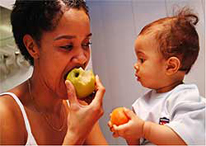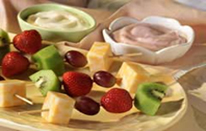It wasn't the healthy meal everyone expected, but on a dreary February morning, the consensus was unanimous: "Mmm... delicious."
The 15-minute meal of sloppy Joe sandwiches, tortilla chips, baby carrots and punch served as the exemplary nutritious meal for the parents to be, as Natalie Webb, a registered dietician, used ingredients from the grocery store down the street, and met all the food group requirements on a tight budget.
Efforts were well received by teens gathered in a home economics room, who quickly polished off their meals, while noting the tips they would need to remember in order to eat healthy and get the proper nutrients during their pregnancies.
"I would have never thought of this," said Mayeline, a senior at Kennedy who is due in March and attended the session with her baby's father, Donny.
 Every year the Montgomery County section of the National Council of Negro Women (NCNW)
Every year the Montgomery County section of the National Council of Negro Women (NCNW)  receives funding from the African American Health Program to raise awareness around a particular health topic. This year they decided to tackle infant mortality, with the four-part workshop, "Better Me, Better Baby, and Better Village."
receives funding from the African American Health Program to raise awareness around a particular health topic. This year they decided to tackle infant mortality, with the four-part workshop, "Better Me, Better Baby, and Better Village."
"It was sort of an ah-ha moment for us," said Pat Grant, president of Montgomery County Section of NCNW. "As we looked at the statistics, especially for the African-American community, we were startled, so we said ‘how can we reach them? How can we work to make families healthy?'"
Infant mortality refers to the death of a child during the first year of life.
In 2004, the U.S. rate for infant mortality was 6.78 deaths per 1,000 live births, mainly due to the high rates in the African-American community at 13.6 deaths per 1,000 live births, according to a report[PDF, 787KB] by the Centers for Disease Control and Prevention (CDC). For teenage girls, the rates for bad birth outcomes can be even higher than their older counterparts within the same ethnic group, as they simultaneously deal with the trials of impending adulthood and motherhood.
"I hope that we raise the awareness of what our theme is saying, Better Me, Better Baby, and Better Village." said Pat Grant. "And for teens, I think it's a lot of information and a lot of them have challenges already."
To raise awareness, the organization is working with teens at Kennedy High School in Silver Spring before taking the message to other area high schools.
"NCNW is about making lives, communities better," said Juanita Goudy, second vice president and College Institute Coordinator at Kennedy. "We're about our seniors, our people and anyone in crisis."
Under the umbrella of A Healthy Baby Begins with You, an African American infant mortality awareness campaign from the HHS Office of Minority Health (OMH), the first session dealt with local and national resources for young, tired and sometimes frustrated parents or anyone who comes in contact with a young child and put emphasis on safe sleeping habits.
OMH's campaign has shown that sometimes there are community and local resources untapped because those who need them don't know they exist. Hotlines, such as OMH Resource Center's 1-800-444-6472 are invaluable for young parents and parents to be, in particular for teens who may not even know which questions to ask.
That was the message Kimberly Myers, OMHRC's information specialist, brought to the event. "We can find resources available for you anywhere in the country. You need to know we are there to help," she said.
The second session focused on the physical aspect of pregnancy with topics of healthy meals and nutrition. To prevent people from crediting budget constraints as an obstruction to healthy eating, Webb dispelled the myths.
"Healthy eating doesn't have to be expensive," Webb said. "The most expensive thing about food is convenience. The more someone does for you the more it's going to cost."
Goudy said she felt that even she benefited from the hands-on demonstration.
 "When you think of eating healthy, sometimes you don't think it will taste good," she said, "now if I can just eat like that from now on, I'll be better off."
"When you think of eating healthy, sometimes you don't think it will taste good," she said, "now if I can just eat like that from now on, I'll be better off."
The two remaining sessions take place during the month of February and deal with the topics of prenatal, infant and mother's care and infant and child safety. As incentives for attendance, participants are given gift cards to neighborhood grocery stores, and baby-safe items, like plugs for electric sockets and locks for cabinet doors.
For this second session, Webb brought students blue, insulated lunch bags with healthy snacks inside. She included a bag of baby carrots, mozzarella cheesesticks, an orange, a trailmix bar, a mini bag of popcorn and about an ounce of canned tuna to show students items in the correct sizes they can consume.
"There's no greater division than the division in health disparities," Webb said.
"The earlier you start in doing the right thing or the wrong thing, the greater impact it's going to have in the long run."
---
Fia Curley is a writer for the OMHRC. Comments? E-mail: fcurley@omhrc.gov
Healthy Meals on a Budget
Select foods in seasonIntroduce yourself to store manager
Don't be afraid to let manager know the items you want to buy
Planning
Make a grocery list
Check for sales and clip coupons
Use cooked cereals (oatmeal) instead of ready-to-eat breakfast cereals
Center meals on grains like rice and pasta
Use small quantities of meat, poultry, fish or eggs
Use legumes (beans and peas) instead of meat, poultry, fish or eggs
Cook large quantities when time and money allow
Shopping
Do not shop when hungry
Select whole foods instead of convenience foods
Try store brands
Buy fresh produce that is in season
Buy only the amount of fresh foods that you will eat before it spoils
Buy large bags of frozen items or dry goods
Buy fat-free dry milk; mix and refrigerate quantities needed fir a day or two
Buy fresh milk by the gallon or half-gallon
Buy less expensive cuts of meat
Buy whole chickens instead of pieces
Compare the unit price (cost per ounce) of similar foods so that you can select the least expensive brand or size
Menu
Sloppy Joes (Meat Food Group, Serves Eight)½ cup chopped red onion
½ cup chopped celery
3 garlic cloves, minced
1 pound ground turkey
One 8-ounce can low-sodium tomato sauce
One 6-ounce can low-sodium tomato pasta
½ cup chili sauce
1 tablespoon white wine vinegar
1 teaspoon ground cumin
½ teaspoon dried oregano
¼ teaspoon black pepper
8 whole-wheat hamburger buns
Directions
1. Coat a large skillet with fat-free cooking spray and heat over medium heat.
2. Add the onion, celery and garlic.
3. Cook until just tender, about four minutes.
4. Add the turkey and cook, breaking up the meat with a spoon. Drain off any excess fat.
5. Stir in the tomato sauce, tomato paste, chili sauce, white wine vinegar, chili powder, cumin, oregano and pepper. Cover and simmer, stirring frequently for about 15 minutes to blend the flavors.
6. Divide the mixture equally among the hamburger buns to make sandwiches.
Fruit Kabobs (Food Groups: Fruit and Dairy, serves 16)
1 cup Vanilla Lowfat Yogurt
2 tablespoons of honey
2 tablespoons fresh lime juice (from one lime)
1 quart strawberries
1 pineapple, cut into chunks
1 small honeydew or cantaloupe melon cut into chunks
1 bunch of grapes
8-inch skewers
Directions
1. In a small bowl mix together Vanilla Lowfat Yogurt, honey, lime juice and zest.
2. Refrigerate at least one hour before using.
3. Alternately thread the fruit onto the skewers.
4. Serve with yogurt dip.
Fruit Punch (Food Group: Fruit, Serves 40)
3 quarts orange juice
2 quarts pineapple juice
2 liters lemon-lime flavored seltzer water
4 cups ice cubes
1 medium orange - sliced
1 medium lemon – sliced
1 medium lime – sliced
Directions
1. Combine juices and seltzer in a punch bowl.
2. Add ice.
3. Lay slices of fruit on ice to garnish.
Links
National Council of Negro Women, Inc.
Eating during Pregnancy

Recipes

Nutrition and Fitness

You will need Adobe Acrobat® Reader™ to view PDF files located on this site. If you do not already have Adobe Acrobat® Reader™, you can download here for free.


